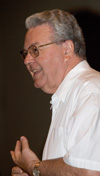Snowmass 2005
Toward an International Linear Collider
Nearly 700 physicists from around the world met in Snowmass, Colorado, to advance plans to create an International Linear Collider, a next generation machine that would answer the most fundamental questions about the universe.
by David Harris
with additional reporting by Heather Rock Woods, Judy Jackson, Elizabeth Clements, and Perrine Royole-Degieux
 The main stairwell of the conference center was an ad hoc meeting spot for many participants. Pier Oddone (left), director of Fermilab, discusses ILC plans with Robin Staffin (center), director of the Department of Energy's Office of High Energy Physics, and Fred Gilman, chair of DOE's High Energy Physics Advisory Panel. |
In the past century, physicists have explored smaller and smaller scales cataloguing the fundamental components of the universe. They have revealed the basic structure of all the matter that humans have ever observed. But in the past decade, physicists have been surprised to discover that what they see can only account for about 5 percent of the universe.
"What could come after this great century of discovery? The consensus I get from community is that best yet to come," says Robin Staffin, director Office High Energy Physics in US Department's Science.
Barry Barish, director of the Global Design Effort (GDE), responsible for formulating plans for an International Linear Collider, says, "Many of the most profound questions in particle physics can be addressed by the next generation of particle accelerators. The International Linear Collider, which would collide electrons and positrons, and the Large Hadron Collider at CERN will provide the collision energy where we expect to begin a new era of discovery."
The ILC would conduct grand experiments, but preparing to build such a machine is an experiment in itself, requiring new forms of international collaboration, communication, and planning. In August, nearly 700 physicists and engineers from around the world converged for two weeks on the mountain village of Snowmass, Colorado, in the hope of creating a basis for the design of the proposed collider. They seek answers to the most compelling questions of particle physics: What is the nature of mass? Are there extra dimensions? Does supersymmetry exist? What is the mysterious dark matter that makes up the majority of the universe's matter? And do the universe's forces all unify at a high energy scale?
Fumihiko Takasaki, regional GDE director for Asia, said, "The ILC would solve some of the big puzzles [of nature] that we haven't yet solved."
Global design effort members Chris Adolphsen, SLAC Jean-Luc Baldy, CERN Philip Bambade, LAL, Orsay Barry Barish, GDE/Caltech Wilhelm Bialowons, DESY Grahame Blair, Royal Holloway, University of London Jim Brau, University of Oregon Karsten Buesser, GDE/DESY Elizabeth Clements, GDE/Fermilab Michael Danilov, ITEP Jean-Pierre Delahaye, CERN Gerald Dugan, Cornell University Atsushi Enomoto, KEK Brian Foster, Oxford University Warren Funk, Jefferson Laboratory Jie Gao, IHEP Terry Garvey, LAL-IN2P3 Hitoshi Hayano, KEK Tom Himel, SLAC Bob Kephart, Fermilab Eun San Kim, Pohang Accelerator Laboratory Hyoung Suk Kim, Kyungpook National University Shane Koscielniak, TRIUMF Vic Kuchler, Fermilab Lutz Lilje, DESY Tom Markiewicz, SLAC David Miller, University College London Shekhar Mishra, Fermilab Youhei Morita, GDE/KEK Olivier Napoly, CEA/Saclay Hasan Padamsee, Cornell University Carlo Pagani, DESY Nan Phinney, SLAC Dieter Proch, DESY Pantaleo Raimondi, INFN Tor Raubenheimer, SLAC Francois Richard, LAL-IN2P3 Perrine Royole-Degieux, GDE/LAL Kenji Saito, KEK Daniel Schulte, CERN Tetsuo Shidara, KEK Sasha Skrinsky, Budker Institute of Nuclear Physics Fumihiko Takasaki, KEK Laurent Jean Tavian, CERN Nobu Toge, KEK Nick Walker, DESY Andy Wolski, LBL Hitoshi Yamamoto, Tohoku University Kaoru Yokoya, KEK |
Converging on Snowmass
The Snowmass 2005 meeting, actually a combination of two workshops, the 2005 International Linear Collider Physics and Detector Workshop and the Second ILC Accelerator Workshop, was a landmark event in the planning of the ILC.
"This is when the members of the GDE met for the first time and it's been fortunate to have two weeks with most of us together," said Barish. The GDE now consists of 49 people from around the globe representing accelerator, detector, and physics research, as well as communication and outreach efforts. (See sidebar for list of GDE members.)
Part of the experiment of planning for an ILC is this approach, with the GDE driving the process rather than it coming top-down from a specific institution, laboratory, or governmental agency.
The primary goal of current efforts, said Nick Walker, GDE member from DESY, is "to make a recommendation on a Baseline Configuration Document" (BCD) by the end of 2005. It will be a document from which further studies, plans, and costs can be developed, prior to completion of a more detailed and technical Reference Design Report by the end of 2006, leading to a Technical Design Report in 2008.
Participants came from all regions—Europe, Asia, and the Americas—with data, analysis, and vision to contribute toward planning an ILC. "These workshops were designed expressly with full international participation on all the committees," said workshop co-chair Ed Berger from Argonne National Laboratory. "We want to do this as an international venture right from day one."
Workshop co-chair Uriel Nauenberg from the University of Colorado said, "Attendance was far more than we expected. We planned for 400 to 450 but got 675. That shows there is tremendous momentum in the community."
 |
The Snowmass process
Prior to Snowmass, accelerator, detector, and physics working groups each tackled different aspects of ILC development. For the duration of the Snowmass meeting, six new Global Groups formed, covering topics such as machine parameters, instrumentation and controls, operations, siting, cost and engineering, and future options. These groups formed a new structure overlaid on the previous working groups to ensure that the best global expertise could draw on the foundations laid by the working groups to move toward the Baseline Configuration Document.
Once at Snowmass, the Global Groups, under coordination of GDE member Tom Himel from SLAC, prepared a set of 40 critical questions for Snowmass. Each question was assigned to a specific Global Group, which had responsibility for collecting information from working groups and other Global Groups and then making recommendations to be considered for the BCD. Following the advice of other members of the GDE and input from the Global Groups' deliberations, Barish will make the final decisions as to what appears in the Baseline Configuration Document.
Accelerator recommendations
GDE member Nan Phinney from SLAC described the work of Global Group 1 (Parameters): "The basic thing for GG1 is to agree on the nominal operating parameters, which we're pretty much in agreement on." The parameter list specifies about 25 properties that the machine would ideally achieve in day-to-day operations. "Another basic thing is to define an operating plane, which means that if one of the nominal parameters is too difficult to achieve, we can still deliver the same luminosity by trading off on another parameter. The point behind the operating plane is to design the machine so we have some flexibility. The principle is not contentious. But whenever you make one parameter easy, you pass the pain to another working group. Any parameter choice causes pain."
To arrive at the parameter list, GG1 experimented with different hypothetical operating modes and looked at the impact on performance. Group members are now close to a final recommendation for the parameter list, being centered on a luminosity of 2x1034 cm-2 sec-1 at 500 GeV collision energy. They recommend a main linear accelerator (main linac) based on superconducting cavities operating at accelerating gradients of 31.5 MV/m based on the DESY TESLA nine-cell cavity design. This would lead to a machine that is approximately 20 km long with a potential upgrade path to a 40 km machine operating at 1 TeV and cavities operating at a higher gradient.
However, producing roughly 20,000 superconducting radio-frequency cavities that meet the specifications will take more research and development. Walker commented, "Regional test facilities are needed to enhance the technological base and enable each region to significantly participate in the main linac and be a possible host of the ILC."
One big question that remains unanswered is the shape and size of the damping rings, which compress bunches of electrons and positrons into tighter bunches with all particles having nearly the same speed, a crucial step before sending the bunches through the main linac to gain energy. Barish acknowledged, "The area that is stickiest is the damping rings—because there is still considerable work to be done and that decision affects a lot of other things."
 |
Monitoring the beam
Getting the electrons and positrons prepared and accelerated is an enormous task, but only the first step in the collision process. Ensuring that the beams are in good shape is one task for Global Group 2 (Instrumentation & Controls). Prior to Snowmass, working groups were developing requirements for beam position monitors (BPMs) that would check that the beams are properly aligned. However, GG2 recommended more precise BPMs that could also be used as a diagnostic tool to reveal much about the performance of the accelerator and provide extra information about luminosity to bolster analysis of collision data. The Global Group noted that prototype BPMs already demonstrate the required resolution for diagnostic use, but some more testing needs to be done before the choice of technology is a "done deal."
GG2 is also responsible for machine protection systems, which ensure that if one part of the accelerator malfunctions, it won't cause serious damage to other parts, one of the aspects of design rated as "high risk" by the US Linear Collider Technology Options Study. Group members acknowledge that several key aspects require innovation and that completing them might have a significant cost impact.
Even with the machine running, operating it and keeping it online is a distinct challenge. Anticipating those issues has an impact on early design work and provides tight constraints on the reliability of every part of the machine. (See sidebar: Keeping an accelerator running)
 Barry Barish, GDE director, addresses the Snowmass meeting. |
Where the beams collide
The ILC collaboration has choices for how the electron and positron arms of the collider are aligned. One option would be for them to point directly at each other. But in that case, electrons and positrons that don't hit each other in the interaction region could travel into the opposite collider arms and disrupt the beams. Instead, the beams will be designed to cross at a slight angle, avoiding this problem but introducing other challenges. For example, the detectors would need to have holes to let the beams in and also to let the beams out, potentially removing some important detection regions from analysis, creating the equivalent of the blind spot on a human retina. Also, space is limited to place the final beam-focusing magnets and other equipment around the detectors. Resolving these issues is up to the machine-detector interface (MDI) team.
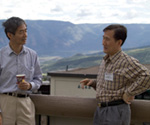 |
Eric Torrence of the University of Oregon characterized the task as "a complicated optimization problem." Every choice involves a trade-off elsewhere in the machine or detector. Balancing the choices must be done so that the best physics can be obtained from the experiments at an acceptable cost, but it is a challenge.
Torrence said that the MDI group is making progress, experimenting with different designs and configurations. The group is currently recommending that the BCD contain a "strawman" design with the possibility of beams crossing in two interaction regions, one at an angle of 20 milliradians, the other at 2 milliradians. However, says Torrence, "It is not at all clear yet which is better. We are working towards even better understanding of the MDI optimization process." Another question still to be answered conclusively is whether the ILC should actually have one interaction region or two.
Keeping an accelerator running Failure of even the smallest component in an accelerator could bring it to its knees. With many millions of components, a large accelerator requires high reliability for them all. If a critical component fails or if enough smaller problems arise, the machine's performance suffers. Replacements and repairs can require shutting down the entire accelerator, as it is not safe to work inside the tunnel while it runs. Because of the need for repairs and maintenance, typical large accelerators are only available to collect data for roughly 40-60% of the time when averaged over a year of operation. Eckhard Elsen from DESY, co-convener of Global Group 3 (Operations and Availability), said that "this is not so impressive and we need better understanding of precisely what contributes to an accelerator's availability. "Because the ILC would have so many components, we can derive the availability of the machine from first principles. A statistical approach, based on the mean time between failures, is possible." Simulation software created by Tom Himel from SLAC allows modeling of the failure of ILC components in all their minutiae. It incorporates measured data on the mean time between failures (MTBF) for all components, typically in the millions-of-hours range, and derives the expected proportion of time that a given configuration of the ILC could run. For example, a model based on a single tunnel for the ILC machine and having all components based on existing technologies could provide an availability of about 64%. A two-tunnel system, which would allow access to some components while the accelerator continues to run, could reach 78% availability. One tunnel with robotic repairs could reach 73% availability. Raising availability to 85% would require an improvement by a factor of 20 on the MTBF for key components. Availability could be significantly increased with other techniques, such as a "keep-alive" positron source, which runs a low-intensity beam during other failures to keep the machine tuned. "One lesson we have learned from these simulations is that we can't be cheap on low-cost items. We have to beware of ?trivial' systems," said Elsen. By using simulations such as those created by Himel, Global Group 3 can determine how extra performance can be obtained from the machine, and at what cost, for a wide range of design decisions. |
Influencing these decisions are potential future upgrades to the ILC and different modes of operation. Global Group 6 (Options) explored the possibilities of one day using the ILC as a photon collider, a factory for Z particles, or for fixed-target experiments. Some of these uses will have specific requirements for the crossing angle and other machine parameters.
The heart of a collision
The ILC will require new types of detectors which surpass previous designs in many ways. Harry Weerts of Argonne National Laboratory said, "The idea is to design a comprehensive linear collider detector that is aggressive in performance but constrained in cost."
Marco Battaglia of Lawrence Berkeley National Laboratory outlined the process of designing a detector: "We define the physics needs—what specific processes do we need to detect at specific energies—and then get the geometry, resolution, readout speed, and material budget from this. We use a number of physics examples to benchmark designs and parameters of detectors."
Going into Snowmass, three "concepts" for detectors were prepared, named SiD, GLD, and LDC. Each concept falls short of being a design, but represents a particular approach to putting together the components of an ILC detector. During the Snowmass meeting, a fourth (unnamed) detector concept was proposed. One characteristic of all the detector concepts is that they hope to use "particle flow algorithms" to determine the trajectories of every charged particle that comes out of a collision. (See sidebar: Particle flows)
Particle flows Traditional accelerators have typically identified particles by the amount of energy they dump in the calorimeter sections of detectors, but ILC detectors will take a different approach—particle flow algorithms. Alexei Raspereza from DESY said, "The basic idea of particle flow algorithms is to obtain optimal [path] reconstruction of every measurable particle in an event." The particle flow algorithms (PFAs) are complicated multi-step processes to determine what precisely happened in a collision. The algorithms typically identify bunches of signals to identify jets of particles or individual particles, remove them from the picture and then look at what is left to find the next set of particles present in the collision remnants. Yasuhiro Sugimoto from KEK commented, "Optimization [of detectors] for particle flow analysis is one of the hottest topics for study in this workshop." Chris Damerell of Rutherford Appleton Laboratory and chair of the ILC R&D Detector Panel said, "Particle flow has been studied for many years but only now have we seen that we can overcome some previously generally accepted limits. Several very important developments have been reported here at Snowmass." |
An advantage of the ILC is that the detectors will record every single collision event that occurs in the interaction region. Hadron colliders, such as Fermilab's Tevatron and the upcoming Large Hadron Collider at CERN, operate with "triggers", which pre-select certain events for recording. This is necessary because hadrons contain multiple quarks, leading to more complex collisions, and producing too much data to fully record. The ILC will store all data for analysis, an advantage when seeking unexpected physical processes.
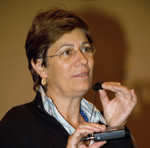 |
Toward detectors
The detector design timetable lags the accelerator timetable, with a review of detector concepts by the ILC R&D Detector Panel due in mid-2006. Weerts commented, "Snowmass 2005 was the first occasion for people interested to participate in [the Silicon Detector concept] SiD to actually spend some time working on the SiD detector."
With detector R&D traditionally separated from accelerator development, funding follows a different pathway. Chris Damerell of Rutherford Appleton Laboratory and chair of the Detector Panel, warned, "Detector funding in Europe is good; in Japan, modest; but in the US, totally inadequate."
Beyond paying for their research and development, the actual detectors are expensive, and would account for 5-10% of the cost of the whole ILC. Marty Breidenbach of SLAC said, "The detector concept groups are just beginning to discuss costs at Snowmass. We aim to gain understanding of the cost scale of detectors, to provide a basis for comparisons, and develop tools for cost-optimizing detector concepts."
Importantly, the Snowmass meeting brought together accelerator and detector scientists. Hitoshi Yamamoto of Tohoku University, from the GLD concept group, said, "We learned about backgrounds and their consequences on the design of the machine-detector interface. Lots of communication is going on. I think it's going very well. Doing the two [accelerator and detector/physics] workshops at the same time was extremely valuable."
Looking to the future, Kiyotomo Kawagoe of Kobe University said, "Concept studies and detector R&D activities are maturing rapidly. We anticipate the amount of activities to increase dramatically, but there is a limited number of facilities for beam tests."
Industry involvement Constructing a project on the scale of the ILC can not be done in-house at any of the particle physics laboratories. Industry partners will be required to build the superconducting radio-frequency cavities, cryogenic components, and other parts of the machine. Regional GDE director for the Americas Gerald Dugan said, "Industrialization is key to this project, but we are behind the curve in the Americas region. The Asian region and the Europeans have functioning industrial forums, where they are much more connected to industry than we are in the US. We are beginning to get there and that's an important focus of this meeting also, and that's an area where Fermilab has to play a big role as the potential site in the US." Robert Kephart from Fermilab commented that for industry, the ILC is a one-off project, not a long-term business, as there is no follow-on from the production of components. He warned that it is not clear that the ILC would be a project of interest to large industrial partners, especially in the United States and Europe, although Japan has a different approach to industrialization and could adopt a different strategy. The ILC might need to use small and medium businesses for much of their industrial collaboration. Early standardization is vital, but meetings with industry so far indicate that it will be able to handle whatever standards the ILC project adopts. After an industrial forum at Snowmass, Nigel Lockyer from Fermilab said, "The industry people are very happy with what is going on." |
Location, location, location
Many aspects of design can be analyzed for the case of an abstract machine that doesn't have a specific site. When it comes to building an actual machine, location has an impact. Geological conditions, local regulations for civil engineering, and proximity to residential communities all matter. During Snowmass, Global Group 4 (Conventional Facilities & Siting) determined the criteria by which sites can be compared and assessed. Barish was pleased that "civil engineers from the three regions came together to agree on how to approach the problem."
As the machine cannot be analyzed solely in the abstract, the BCD will include sample sites from each of the Americas, Europe, and Asia to provide real-world scenarios for understanding the difficult issues behind siting the accelerator.
"The current effort is not intended to select a potential site, but rather to understand from the beginning how the features of sites will affect the design, performance, and cost. We are not assuming any of these sample sites will be the actual site," cautioned Walker.
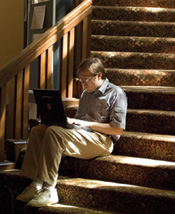 |
A cost in any currency
Getting deeper into the nuts and bolts of the ILC is Global Group 5 (Cost & Engineering). Every region of the world tends to use different project and engineering standards. Through their deliberations, GG5 is coming to terms with what the design reports must specify, and in what level of detail, to be able to build the ILC using resources and industrial involvement from all parts of the world. (See sidebar: Industry involvement)
Developing costs for the ILC and finding ways to translate them into different currencies and apportion them between partners is even more challenging. Fortunately, there are some pre-existing models to learn from and GG5 has studied those precedents as it prepares recommendations for the GDE. (See sidebar: Lessons for costing from ITER)
What is clear from Snowmass is that concerns about cost infuse every discussion. Even theorists, usually immune to the topic, were discussing it. "As a theorist, my job is to drive costs up," joked Michael Peskin from SLAC. "But cost affects everything now. It means you have to ?triage' the detection and focus on the really essential physics results."
Barish emphasized the importance of cost. "We need to make technical and cost considerations, especially between now and the end of the year. I want that [cost] in immediately and not after we create the baseline. It will be an integral part in making choices."
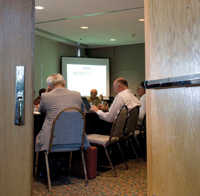 |
Theory meets experiment
Theorists played a significant role in what looked on the surface to be an experimenters' meeting. They gathered in a variety of sessions, including working groups on the top particle, quantum chromodynamics, the Higgs particle, supersymmetry, and beyond the Standard Model physics. Theorists also turned up at the experimental sessions asking questions that helped focus their efforts, and provided results from theory regarding what detectors should be able to observe and what performance would be needed from the accelerator.
Many studies were commenced, continued, or completed during the Snowmass meeting. Peskin commented, "The calculations are coming together at the needed precision to distinguish [theoretical] models from a set of ILC measurements." And although the focus was on physics particularly relevant to the ILC, the LHC's overlapping interests were relevant. Peskin remarked, "Some spinoffs [from the ILC work] include how to better do LHC calculations."
Lessons for costing from ITER How do countries, with their different currencies and approaches to costing, agree on the costs, values, and sharing of parts of a large international project? During the Snowmass meeting, CERN director-general Robert Aymar addressed this question by discussing his experiences with the ITER project, an international experimental burning-plasma facility for the production of fusion energy, recently assigned a construction site near Cadarache, France. Aymar compared two types of costing mechanism. The ITER project developed its own artificial currency (the "ITER Unit of Account") for determining the value of contributions to the project, which could then be converted into real costs in a particular country's currency. A different mechanism is the "strong central host" model, such as used by CERN's Large Hadron Collider. Aymar emphasized that a detailed design and a deep understanding of its costs must be developed before starting. In ITER's case, this was developed via an Engineering Design Activities (EDA) treaty. The ratio of EDA to construction costs will vary depending on the approach to the project. Aymar said, "There is no theological basis for the ratio, but you will pay either before or after. For the LHC, we paid after. It would have been better to do it before." For ILC costing, Robert Kephart from Fermilab, in an acting role as one of three Global Group 5 (Cost & Engineering) co-conveners, has proposed a modified ITER model. He says, "I believe we can create a ?core cost' for the ILC." That core cost would exclude region-dependent factors. "Regions can then interpret these numbers in ways funding agencies [in specific countries] are used to." Aymar's final words of advice to Global Group 5 were to define a goal. "Our goal for ITER was to provide each party with an understanding of an equitable contribution," he said. "Presenting the cost estimate for the ILC is totally different. You have to put in very strong terms what the goal is for the costing estimate." |
Communicating the need for the ILC
Doing the research and development on the ILC is not enough to ensure it will be built. Peskin said, "We have won the battle in the particle physics community that the ILC is next. Now there is a broader challenge to argue the case to other scientists, to political leaders, and to the public."
Joe Lykken of Fermilab pointed out, "We have made a strong physics case, but only begun to communicate that strong physics case," a message backed up by Staffin: "Reserve your highest standards for this [communications] endeavor. Governments will take notice."
Randal Ruchti from the National Science Foundation said, "While the ILC may be a number of years away to be fully realized, broader impacts and issues can and should be emphasized early."
Progress made
Toward the end of the meeting, participants were upbeat about their progress. Albrecht Wagner, director-general of DESY, said, "We see really a convergence in this week and last week to a Baseline Configuration Document."
In terms of specifics, Walker commented that, "The 40 critical BCD questions assembled by Tom Himel have effectively been answered. However, these are not the final answers as we want to go back to the global community. We are close to having the necessary recommendations for the BCD although there are still many details to be worked out."
In the short term, the community is focusing on the Baseline Configuration Document for the end of the year. It will provide a firm foundation for further studies, but Barish puts it in perspective. "The baseline configuration is not final—it will allow us to understand what we have; how we'll build it; the cost. The R&D path on the timeline continues while the technical design is being done. This will enable us to keep on improving on what we can do. That's how we evolve a design that's not obsolete by the time the machine breaks ground."
In early 2006, the BCD will be handed over to a Change Control Board, responsible for maintaining the baseline document and deciding on whether proposed changes should be added. This control is needed to ensure that any proposed change will not inadvertently affect other parts of the ILC.
 |
The future
Discussing how to move forward with the ILC, outgoing chair of the High-Energy Physics Advisory Panel (HEPAP) Fred Gilman said, "We must dramatically reprogram the field, assuming the current level of funding in the next few years, in order to free up resources to ramp up the ILC effort."
Staffin confirmed that, "DOE has expressed its support for an ILC." Earlier, at a speech at SLAC on August 4, 2005, US Secretary of Energy Samuel Bodman said that he would like to see the ILC built, and built in the United States. Shin-ichi Kurokawa, chair of the Asian Committee on Future Accelerators (ACFA) also expressed his region's interest, "ACFA strives to get the ILC in Asia. Let us collaborate by overcoming differences among us and in our regions for the realization of ILC."
The success of the Snowmass meeting has renewed confidence in the ILC process. Jonathan Dorfan, chair of the International Committee for Future Accelerators (ICFA) commented, "If we continue to behave responsibly, as we have, and we continue to follow the science, we will have an ILC in the future."
Photos: Fred Ullrich and Reidar Hahn, Fermilab
Click here to download the pdf version of this article.



